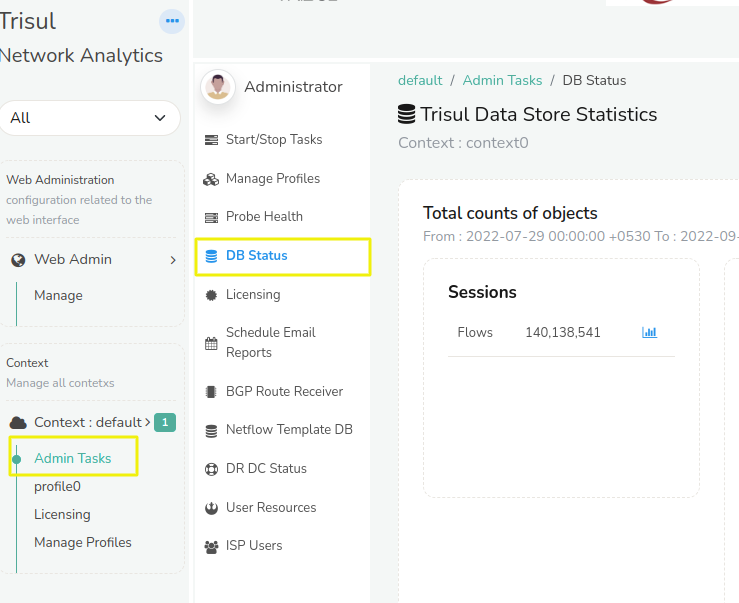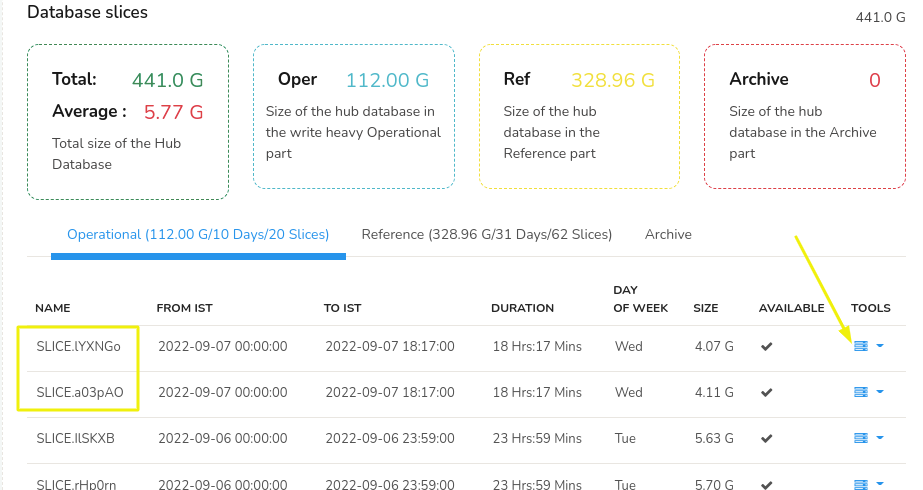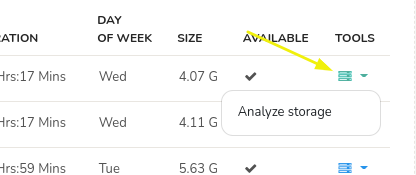Tuning database usage
The default deployment of Trisul will store all metrics at its native resolution. This is by design so the Trisul database can be used as a source for incident response, post breach audit, and compliance. However this can result in relatively high storage.
Finding out disk usage per day
To find out how much disk is being used per day.
You will be shown the DB status page like this

The following data is shown on this page
- Count of objects – Sessions (flows), resources, and alerts
- Total disk usage in oper, ref, and archive points
- Per slice , per day usage
- PCAP usage
Per day storage
The following table shows per Slice storage. A Slice is a unit of storage in Trisul, typically each day has two slices. Hence to get the storage for a day you add the storage of slices with the same date.

In the above picture for the day 09-07-2022 represented by the two slices highlighted. The total storage for that day would be 4.07 GB + 4.11 GB = 8.18 GB
To view detailed analysis
Each database slice further contains many storage subsections of the Trisul database, you can use the Analyze Storage option. This is used by Trisul Engineers to further fine tune the database.

Tuning the database
The default install of Trisul Network Analytics stores data for 92 days, i.e. 3 months.
You can tune the database to extend the storage to co er more number of days.
Tuning the Flow / Sessions database
The biggest component of Trisul Network Analytics database storage is typically the Flow or Session database. A flow represents a single unit of datatransfer. This is a record that captures Protocol-SourceIP-SourcePort-DestIP-DestPort bytes packets timestamp etc. Trisul stores every single flow that passes through the network even if it only transferred 10 bytes or 10 Gigabytes. This is required because Trisul is used by many customers for audit, incident response, post breach investigations, and compliance. This application requires every single flow because malware may only use small flows.
Customers whose primary use cases are Visiblility and Detection features of Trisul can dramatically reduce the size of the flow database by using “Volume Cutoff Bytes”. See User Guide: Flow Tuning
Set Volume Cutoff Bytes to 1MB
The flow database has a property that it uses a fixed amount of storage regardless of the datatransfer. Traffic research indicates that 80% of flows transfer less than 10% of total traffic. Hence if you set the ‘Volume Cutoff Bytes’ to 1MB it will dramatically reduce the storage by roughly 80%. You can adjust this value for further optimization gains.

Advantages and disadvantages of Volume Cutoff bytes
By setting the Volume Cutoff Bytes to a value like 1MB – the customer gains the following
- All flows that transferred greater than 1MB are still stored, hence full visibility is still available for large flows
- The total size of the Trisul database is greatly reduced
- This allows customers to store more number of days with the same storage
The following disadvantages for customers whose use case includes security, incident response, and compliance.
- During incident response you will not be able to find small flows that transferred less than the 1MB flow cutoff.
In general , we recommend customers whose primary use case is visibilty and network monitoring to set a “Volume Cutoff Bytes” of 1MB for maximum optimization of disk.
Optimize Edges
Edge Analytics are an advanced Trisul feature used primary for security investigations. “Edges” can also use up quite a bit of disk.
- You can disable Edges by opening the Trisul Config file and disable the Edge options. See Edge trisulProbeConfig
Counter groups
Counter groups have the following parameters that can be tuned
- High Water and Low Water — This impacts how many “items” of this counter group are stored.
- Topper Traffic Only — If you set this , then only keys that make it to a topper list are stored.
- Top Count — By setting lower values you can control the storage.